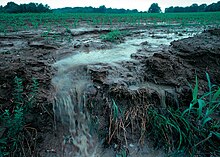Nutrient pollution
[1] Sources of nutrient pollution include surface runoff from farm fields and pastures, discharges from septic tanks and feedlots, and emissions from combustion.
These include eutrophication of surface waters, harmful algal blooms, hypoxia, acid rain, nitrogen saturation in forests, and climate change.
[4] When nitrogen and phosphorus are not fully utilized by the growing plants, they can be lost from the farm fields and negatively impact air and downstream water quality.
[6] When farmers spread their fertilizer, whether it is organic or synthetically made, some of it will leave as runoff and can collect downstream generating cultural eutrophication.
[10] In order to gauge how to best prevent eutrophication from occurring, specific sources that contribute to nutrient loading must be identified.
[11] Globally, nitrogen balances are quite inefficiently distributed with some countries having surpluses and others deficits, causing especially a range of environmental issues in the former.
However, farmers frequently apply more nutrients than are needed by crops, resulting in the excess pollution running off into either surface or groundwater.
Regulations aimed at minimizing nutrient exports from agriculture are typically far less stringent than those placed on sewage treatment plants[22] and other point source polluters.
Runoff can wash out the mineral nitrogen and phosphorus from detritus and in consequence supply the water bodies leading to slow, natural eutrophication.
[24] Atmospheric deposition (e.g., in the form of acid rain) can also affect nutrient concentration in water,[25] especially in highly industrialized regions.
[31] A 2013 Forest Trends report summarized water quality trading programs and found three main types of funders: beneficiaries of watershed protection, polluters compensating for their impacts and "public good payers" that may not directly benefit, but fund the pollution reduction credits on behalf of a government or NGO.
Agriculture is typically the principal source of nitrogen in water bodies in Europe, whereas in many countries households and industries tend to be the dominant contributors of phosphorus.
[37] Based on surveys by state environmental agencies, agricultural nonpoint source (NPS) pollution is the largest source of water quality impairments throughout the U.S..[38]: 10 NPS pollution is not subject to discharge permits under the federal Clean Water Act (CWA).
[39] EPA and states have used grants, partnerships and demonstration projects to create incentives for farmers to adjust their practices and reduce surface runoff.
Implementing this water quality program has been a major scientific, technical and resource-intensive challenge for both EPA and the states, and development is continuing well into the 21st century.
EPA published a wastewater management regulation in 1978 to address the national nitrogen pollution problem, which had been increasing for decades.
[46] In 2011 EPA reiterated the need for states to fully develop their nutrient standards, noting that drinking water violations for nitrates had doubled in eight years, that half of all streams nationwide had medium to high levels of nitrogen and phosphorus, and harmful algal blooms were increasing.
[51] Surface runoff from farm fields, the principal source of nutrients in many watersheds,[52] is classified as NPS pollution and is not regulated by NPDES permits.
[53] Specifically, Section 303 of the Act requires each state to generate a TMDL report for each body of water impaired by pollutants.
[53] EPA published a TMDL for the Chesapeake Bay in 2010, addressing nitrogen, phosphorus and sediment pollution for the entire watershed, covering an area of 64,000 square miles (170,000 km2).



